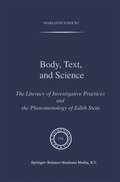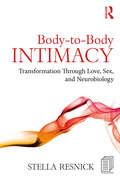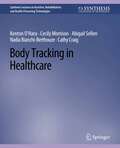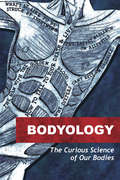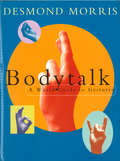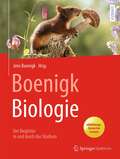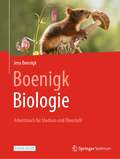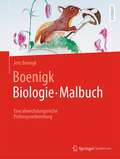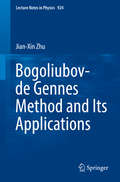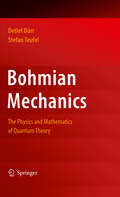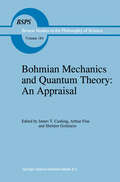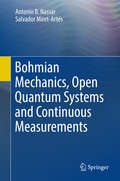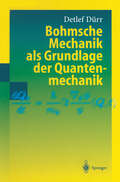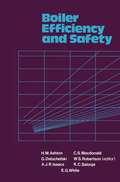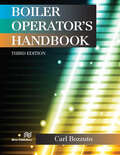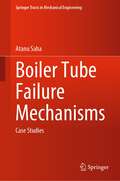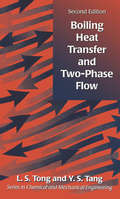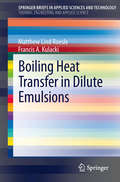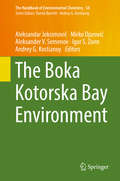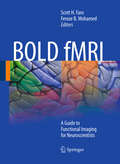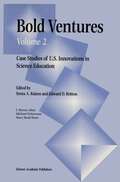- Table View
- List View
Body, Text, and Science: The Literacy of Investigative Practices and the Phenomenology of Edith Stein (Phaenomenologica #144)
by M. SawickiWhat is "scientific" about the natural and human sciences? Precisely this: the legibility of our worlds and the distinctive reading strategies that they provoke. That account of the essence of science comes from Edith Stein, who as HusserI's assistant 1916-1918 labored in vain to bring his massive Ideen to publication, and then went on to propose her own solution to the problem of finding a unified foundation for the social and physical sciences. Stein argued that human bodily life itself affords direct access to the interplay of natural causality, cultural motivation, and personal initiative in history and technology. She developed this line of approach to the sciences in her early scholarly publications, which too soon were overshadowed by her religious lectures and writings, and eventually were obscured by National Socialism's ideological attack on philosophies of empathy. Today, as her church prepares to declare Stein a saint, her secular philosophical achievements deserve another look.
Body-to-Body Intimacy: Transformation Through Love, Sex, and Neurobiology
by Stella ResnickThis book presents an integrative, growth-oriented approach to therapy with couples that demonstrates the dynamic interplay between partners’ emotional issues and their sexual difficulties. It offers a model for relational and sexual enhancement that focuses as much on partners’ present, nonverbal body-to-body communications as on their words. Dr. Stella Resnick draws on research from interpersonal neurobiology, sexology, positive psychology, and Gestalt therapy, and shares a rich assortment of therapy vignettes to demonstrate the transformative power of pleasure and how a focus on body-to-body intimacy can heal emotional wounds from the past and encourage greater presence, empathy, authenticity, playfulness, and sexual pleasure between intimate partners. The therapeutic process is explored in four related spectrums: the Problem-Transformation Spectrum, the Attachment-Sexuality Spectrum, the Pain-Pleasure Spectrum, and the Cognitive-Somatic-Experiential-Behavioral-Spectrum. Part I lays the theoretical foundation for the work. Part II examines the early attachment bond between parent and child and its effects on adult capacity for emotional closeness and sexual pleasure. Part III offers methods for resolving painful emotional issues underlying many sexual difficulties. Finally, Part IV describes the procedure for moving from a cognitive reframing of the problem to a somatic focus on the body and tracking present-moment emotional interactions to the repair of relational injuries that nurture transformational change. Also included is a series of process-oriented exercises and a handout that therapists can use in their own practice. Body-to-Body Intimacy will enable couples and sex therapists to expand their practices and enrich their clients’ sexual and relational dynamics. This book also contains valuable information that will be appreciated by anyone interested in a greater understanding of a growth-oriented therapeutic process for couples and what can be achieved together by gaining a deeply loving and sexually fulfilling intimate love relationship.
Body-to-Body Intimacy: Transformation Through Love, Sex, and Neurobiology
by Stella ResnickThis book presents an integrative, growth-oriented approach to therapy with couples that demonstrates the dynamic interplay between partners’ emotional issues and their sexual difficulties. It offers a model for relational and sexual enhancement that focuses as much on partners’ present, nonverbal body-to-body communications as on their words. Dr. Stella Resnick draws on research from interpersonal neurobiology, sexology, positive psychology, and Gestalt therapy, and shares a rich assortment of therapy vignettes to demonstrate the transformative power of pleasure and how a focus on body-to-body intimacy can heal emotional wounds from the past and encourage greater presence, empathy, authenticity, playfulness, and sexual pleasure between intimate partners. The therapeutic process is explored in four related spectrums: the Problem-Transformation Spectrum, the Attachment-Sexuality Spectrum, the Pain-Pleasure Spectrum, and the Cognitive-Somatic-Experiential-Behavioral-Spectrum. Part I lays the theoretical foundation for the work. Part II examines the early attachment bond between parent and child and its effects on adult capacity for emotional closeness and sexual pleasure. Part III offers methods for resolving painful emotional issues underlying many sexual difficulties. Finally, Part IV describes the procedure for moving from a cognitive reframing of the problem to a somatic focus on the body and tracking present-moment emotional interactions to the repair of relational injuries that nurture transformational change. Also included is a series of process-oriented exercises and a handout that therapists can use in their own practice. Body-to-Body Intimacy will enable couples and sex therapists to expand their practices and enrich their clients’ sexual and relational dynamics. This book also contains valuable information that will be appreciated by anyone interested in a greater understanding of a growth-oriented therapeutic process for couples and what can be achieved together by gaining a deeply loving and sexually fulfilling intimate love relationship.
Body Tracking in Healthcare (Synthesis Lectures on Assistive, Rehabilitative, and Health-Preserving Technologies)
by Kenton O'Hara Cecily Morrison Abigail Sellen Nadia Bianchi-Berthouze Cathy CraigWithin the context of healthcare, there has been a long-standing interest in understanding the posture and movement of the human body. Gait analysis work over the years has looked to articulate the patterns and parameters of this movement both for a normal healthy body and in a range of movement-based disorders. In recent years, these efforts to understand the moving body have been transformed by significant advances in sensing technologies and computational analysis techniques all offering new ways for the moving body to be tracked, measured, and interpreted. While much of this work has been largely research focused, as the field matures, we are seeing more shifts into clinical practice. As a consequence, there is an increasing need to understand these sensing technologies over and above the specific capabilities to track, measure, and infer patterns of movement in themselves. Rather, there is an imperative to understand how the material form of these technologies enables them also to be situated in everyday healthcare contexts and practices. There are significant mutually interdependent ties between the fundamental characteristics and assumptions of these technologies and the configurations of everyday collaborative practices that are possible them. Our attention then must look to social, clinical, and technical relations pertaining to these various body technologies that may play out in particular ways across a range of different healthcare contexts and stakeholders. Our aim in this book is to explore these issues with key examples illustrating how social contexts of use relate to the properties and assumptions bound up in particular choices of body-tracking technology. We do this through a focus on three core application areas in healthcare—assessment, rehabilitation, and surgical interaction—and recent efforts to apply body-tracking technologies to them.
Bodyology: The Curious Science of Our Bodies
by Mosaic ScienceEver wondered what it’s like to be hit by lightning or to lose your sense of smell? Heard about the woman saved by bee stings — or the window cleaner who survived a 400ft fall? Originally written for the Wellcome charity, these 16 stories by leading science writers explore the mysteries of the human body. Learn about everything from diets to allergies, hair colour to rare blood, and from allergies to remote surgery. Contents What’s it like to be struck by lightning? Why do we colour hair? The man with the golden blood Why dieters can’t rely on calories 3D printers can now make body parts How to fall from a skyscraper and live to tell the tale The quest to explain miscarriages Seeking a ‘cure’ for male baldness How bee stings saved a woman’s life The global trend for ‘kangaroo’ babies What it means to lose your sense of smell The doctor aiming to end eye pain Could allergies be a defence against noxious chemicals? Why business is going slow on the male pill How virtual reality headsets aid remote surgery Shhh! What exactly is the menopause?
Bodytalk: A World Guide to Gestures
by Desmond MorrisThe first book to bring together the many different everyday gestures that are used all over the world. Desmond Morris has travelled to over 60 countries while making field studies of human body language, and made notes of hand gestures and facial expressions. The result is a fascinating reference book of over 600 different gestures from Europe, the Middle East, North & South America and the Far East. The book is arranged alphabetically under the part of the body used with Meaning, Action, Background and Locality and each gesture is illustrated with a line drawing. The World Guide to Gestures complements Desmond Morris's bestsellers Manwatching and Bodywatching.
Boenigk, Biologie: Der Begleiter in und durch das Studium
Der Boenigk setzt einen neuen Standard in der Biologie und macht das Lernen für die zukünftige Generation von Naturwissenschaftler*innen nicht nur spannend, sondern auch einfach. Dieses einzigartige und ganz neu konzipierte Lehrbuch ist von einem erfahrenen Biologenteam speziell auf die Bedürfnisse der Studierenden im Bachelor zugeschnitten und für den deutschsprachigen Bereich konzipiert.In den einzelnen Kapiteln spannen die Autor*innen einen weiten Bogen über Lehrinhalte und aktuelle Forschungsthemen aller Felder der Biologie, wie Zellbiologie, Genetik, Physiologie, Evolution und Ökologie. Neben Tieren und Pflanzen werden auch Pilze, Algen, Protisten, Bakterien und Archaeen eingehend behandelt. Darüber hinaus werden aktuelle Themenfelder wie Mikrobiologie und Epigenetik aber auch der Klimawandel und die COVID-19-Pandemie ausführlich berücksichtigt.Durch Vergleiche zwischen verschiedenen Organismengruppen und zahlreiche Querverweise werden die grundlegenden biologischen Prozesse und Zusammenhänge für Einsteiger*innen schneller begreifbar. Kurze und durch die starke Bebilderung einprägsame Konzepte bringen die Inhalte auf den Punkt und vermeiden langatmige und unverständliche Textwüsten. Verstehen steht bei diesem Werk im Vordergrund im Gegensatz zu schnödem Auswendiglernen. Langweilig war gestern! Dieses innovative Lehrbuch bietet:mehr Inhalt auf weniger Seiten durch ein neues abbildungszentriertes didaktisches Konzeptvisuelles Lernen durch anschauliche Verschmelzung von Abbildung und Textgut strukturierte Inhaltedie ideale Vorbereitung für die Prüfung Der Boenigk richtet sich an Studierende der Biologie, die einen übersichtlichen Einstieg ins Studium und einen kompetenten Begleiter fürs Studium suchen – sogar über den Bachelor hinaus. Hochschuldozenten*innen und Lehrer*innen, die auf aussagekräftige und didaktisch aufbereitete Abbildungen Wert legen, finden hier hochwertiges Material für die Lehre. Und alle, die über den Tellerrand des Schulcurriculums blicken möchten, können sich einfach einlesen.
Boenigk, Biologie - Arbeitsbuch für Studium und Oberstufe
by Jens BoenigkBereitest du dich gerade auf Prüfungen oder Klausuren im Biologie-Bachelor vor? Oder lernst du für das Abitur oder die Matura? Dann bietet dir dieses Buch die ideale Hilfestellung. In Verbindung mit dem Lehrbuch BOENIGK BIOLOGIE (2021) setzt das Arbeitsbuch auf ein umfassendes geistiges Training und vernetztes Lernen mit einem Schwerpunkt auf Lückentexten, Beschriftungsaufgaben und Freitextaufgaben. Die Übungsaufgaben umfassen Themen der Cytologie, der Genetik, der Physiologie, der Evolution und Systematik, der Ökologie sowie der molekularen Grundlagen der Biologie und sind abgestimmt auf Themen der Oberstufe und des grundständigen Studiums. Das Übungsbuch eignet sich darüber hinaus für den Einsatz in der digitalen Lehre in der Schule und in Kursen des grundständigen Studiums und richtet sich somit auch an Lehrer*innen und Dozent*innen. Die farbigen Arbeitsblätter erlauben Lösungen direkt in die Formularfelder der eBook-Version einzugeben. Die enge Anlehnung der Arbeitsblätter an einzelne, in sich abgeschlossene Unterkapitel des Lehrbuchs BOENIGK BIOLOGIE (2021) fördert die selbstständige Erarbeitung der jeweiligen Themenfelder durch aktive Nutzung des Lehrbuchs. Für Lehrkräfte sind die Lösungen zudem als Online-Materialien verfügbar.
Boenigk, Biologie - Malbuch: Eine abwechslungsreiche Prüfungsvorbereitung
by Jens BoenigkDieses Zeichen- und Malbuch bietet eine schnelle Abhilfe für alldiejenigen, die Schwierigkeiten haben sich chemische Strukturen zu merken oder ihr Wissen über biologische Moleküle und Strukturen vertiefen möchten. Vielseitige Aufgabenstellungen bieten reichhaltige Abwechslung, um sich den Lernstoff für die anstehende Prüfung zu merken. Es ist eine einfache und abwechslungsreiche Alternative für die Prüfungsvorbereitung, die fast ein wenig Spaß macht. Unterschiedliche Aufgabentypen gehen spezifisch darauf ein, wie sich der Lernstoff am besten gemerkt werden kann. So malt man in einigen Aufgaben spezifische Strukturen in unterschiedlichen Farben aus oder wird getestet, ob man bestimmte Strukturen sogar frei aus dem Gedächtnis zeichnen kann. Die Aufgaben sind an die Inhalte des Lehrbuchs BOENIGK BIOLOGIE angelehnt und decken folgende Themengebiete ab: - Cytologie- Genetik- Physiologie- Evolution uns Systematik- Ökologie
Bogoliubov-de Gennes Method and Its Applications (Lecture Notes in Physics #924)
by Jian-Xin ZhuThe purpose of this book is to provide an elementary yet systematic description of the Bogoliubov-de Gennes (BdG) equations, their unique symmetry properties and their relation to Green’s function theory. Specifically, it introduces readers to the supercell technique for the solutions of the BdG equations, as well as other related techniques for more rapidly solving the equations in practical applications.The BdG equations are derived from a microscopic model Hamiltonian with an effective pairing interaction and fully capture the local electronic structure through self-consistent solutions via exact diagonalization. This approach has been successfully generalized to study many aspects of conventional and unconventional superconductors with inhomogeneities – including defects, disorder or the presence of a magnetic field – and becomes an even more attractive choice when the first-principles information of a typical superconductor is incorporated via the construction of a low-energy tight-binding model. Further, the lattice BdG approach is essential when theoretical results for local electronic states around such defects are compared with the scanning tunneling microscopy measurements.Altogether, these lectures provide a timely primer for graduate students and non-specialist researchers, while also offering a useful reference guide for experts in the field.
Bohmian Mechanics: The Physics and Mathematics of Quantum Theory
by Detlef Dürr Stefan TeufelBohmian Mechanics was formulated in 1952 by David Bohm as a complete theory of quantum phenomena based on a particle picture. It was promoted some decades later by John S. Bell, who, intrigued by the manifestly nonlocal structure of the theory, was led to his famous Bell's inequalities. Experimental tests of the inequalities verified that nature is indeed nonlocal. Bohmian mechanics has since then prospered as the straightforward completion of quantum mechanics. This book provides a systematic introduction to Bohmian mechanics and to the mathematical abstractions of quantum mechanics, which range from the self-adjointness of the Schrödinger operator to scattering theory. It explains how the quantum formalism emerges when Boltzmann's ideas about statistical mechanics are applied to Bohmian mechanics. The book is self-contained, mathematically rigorous and an ideal starting point for a fundamental approach to quantum mechanics. It will appeal to students and newcomers to the field, as well as to established scientists seeking a clear exposition of the theory.
Bohmian Mechanics and Quantum Theory: An Appraisal (Boston Studies in the Philosophy and History of Science #184)
by J. T. Cushing Arthur Fine S. GoldsteinWe are often told that quantum phenomena demand radical revisions of our scientific world view and that no physical theory describing well defined objects, such as particles described by their positions, evolving in a well defined way, let alone deterministically, can account for such phenomena. The great majority of physicists continue to subscribe to this view, despite the fact that just such a deterministic theory, accounting for all of the phe nomena of nonrelativistic quantum mechanics, was proposed by David Bohm more than four decades ago and has arguably been around almost since the inception of quantum mechanics itself. Our purpose in asking colleagues to write the essays for this volume has not been to produce a Festschrift in honor of David Bohm (worthy an undertaking as that would have been) or to gather together a collection of papers simply stating uncritically Bohm's views on quantum mechanics. The central theme around which the essays in this volume are arranged is David Bohm's version of quantum mechanics. It has by now become fairly standard practice to refer to his theory as Bohmian mechanics and to the larger conceptual framework within which this is located as the causal quantum theory program. While it is true that one can have reservations about the appropriateness of these specific labels, both do elicit distinc tive images characteristic of the key concepts of these approaches and such terminology does serve effectively to contrast this class of theories with more standard formulations of quantum theory.
Bohmian Mechanics, Open Quantum Systems and Continuous Measurements
by Antonio B. Nassar Salvador Miret-ArtésThis book shows how Bohmian mechanics overcomes the need for a measurement postulate involving wave function collapse. The measuring process plays a very important role in quantum mechanics. It has been widely analyzed within the Copenhagen approach through the Born and von Neumann postulates, with later extension due to Lüders. In contrast, much less effort has been invested in the measurement theory within the Bohmian mechanics framework. The continuous measurement (sharp and fuzzy, or strong and weak) problem is considered here in this framework. The authors begin by generalizing the so-called Mensky approach, which is based on restricted path integral through quantum corridors. The measuring system is then considered to be an open quantum system following a stochastic Schrödinger equation. Quantum stochastic trajectories (in the Bohmian sense) and their role in basic quantum processes are discussed in detail. The decoherence process is thereby described in terms of classical trajectories issuing from the violation of the noncrossing rule of quantum trajectories.
Bohmsche Mechanik als Grundlage der Quantenmechanik
by Detlef DürrIn diesem Buch wird erstmalig in deutscher Sprache vorgestellt, wie sich aus einer fundamentalen mechanischen Theorie, nämlich Bohmscher Mechanik, der mathematische Formalismus und die Phänomene der Quantenmechanik ergeben. Dies steht in Analogie zur Idee, die makroskopischen Phänomene aus den mikroskopischen fundamentalen Gesetzen zu erklären. Dieses Programm wird hier vollständig in mathematischer Strenge durchgeführt, wobei die benötigten Methoden und Grundeinsichten eingeführt und erklärt werden. Nach ausführlicher Darstellung der Grundlagen beschäftigt sich der Autor mit der statistischen Analyse der Bohmschen Mechanik und entwickelt daraus die fundamentalen Konzepte der Quantenmechanik einschließlich der bisher in dieser Form noch nicht dargestellten Streutheorie. Das Buch wirft ein neues Licht auf die Grundlagenprobleme und die Paradoxien der Quantenmechanik und verbindet strengen mathematischen Formalismus mit physikalischer Anschauung.
Boiler Efficiency and Safety: A Guide for Managers, Engineers and Operators responsible for Small Steam Boilers
by W. L. RobertsonBoiler Operator's Handbook
by Carl BuzzutoWith the increased interest in climate impacts, sustainability, and efficiency, more responsibility is being placed on boiler operators to help improve performance and reduce emissions. This third edition of the Boiler Operator’s Handbook is intended to help such operators in the quest for improved operability and performance of their boilers and their plants. The theme of this book is to "operate wisely". The goal is to instill not only "know how" but "know why". The main details have been provided by the original author, Mr. Ken Heselton. This updated version has been somewhat expanded to include a wider range of examples and some of the more recent environmental requirements. To illustrate these points, topics include multi boiler operations, understanding the plant load, maintenance issues, and controls. Every plant is different. However, it is hoped that with the information provided in this book, the wise operator will be able to address the various unique issues posed by the specific plant and provide timely solutions to meet the present-day requirements.
Boiler Operator's Handbook
by Carl BuzzutoWith the increased interest in climate impacts, sustainability, and efficiency, more responsibility is being placed on boiler operators to help improve performance and reduce emissions. This third edition of the Boiler Operator’s Handbook is intended to help such operators in the quest for improved operability and performance of their boilers and their plants. The theme of this book is to "operate wisely". The goal is to instill not only "know how" but "know why". The main details have been provided by the original author, Mr. Ken Heselton. This updated version has been somewhat expanded to include a wider range of examples and some of the more recent environmental requirements. To illustrate these points, topics include multi boiler operations, understanding the plant load, maintenance issues, and controls. Every plant is different. However, it is hoped that with the information provided in this book, the wise operator will be able to address the various unique issues posed by the specific plant and provide timely solutions to meet the present-day requirements.
Boiler Tube Failure Mechanisms: Case Studies (Springer Tracts in Mechanical Engineering)
by Atanu SahaThis book presents failure mechanisms of different boiler components and preventive measures. It illustrates the basic steam flow and circuit design of steam boiler, boiler design parameters, boiler components materials and their behavior at different temperatures. The book aims to identify the cause(s) of in-service failure of secondary superheater tube, platen superheater tube and furnace water wall tube and also presents the solutions to avoid the future failures. This volume will be of interest to researchers and professionals working in the areas of energy, power generation, electric power plants, thermodynamics, industrial chemistry, etc.
Boiling Heat Transfer And Two-Phase Flow
by L S TongCompletely updated, this graduate text describes the current state of boiling heat transfer and two-phase flow, in terms through which students can attain a consistent understanding. Prediction of real or potential boiling heat transfer behaviour, both in steady and transient states, is covered to aid engineering design of reliable and effective systems.
Boiling Heat Transfer And Two-Phase Flow
by L S TongCompletely updated, this graduate text describes the current state of boiling heat transfer and two-phase flow, in terms through which students can attain a consistent understanding. Prediction of real or potential boiling heat transfer behaviour, both in steady and transient states, is covered to aid engineering design of reliable and effective systems.
Boiling Heat Transfer in Dilute Emulsions (SpringerBriefs in Applied Sciences and Technology)
by Matthew Lind Roesle Francis A. KulackiBoiling Heat Transfer in Dilute Emulsions synthesizes recent advances and established understanding on the subject of boiling in dilute emulsions. Experimental results from various sources are collected and analyzed, including contemporary experiments that correlate visualization with heat transfer data. Published models of boiling heat transfer in dilute emulsions, and their implementation, are described and assessed against experimental data.
Boiling liquid maintaining it's temperature (Graph) (tactile)
by Sheffield Vi ServiceThis is a graph showing how a boiling liquid remains at a constant temperature.
The Boka Kotorska Bay Environment (The Handbook of Environmental Chemistry #54)
by Aleksandar Joksimović Mirko Djurović Aleksander V. Semenov Igor S. Zonn Andrey G. KostianoyThis book focuses on environmental aspects of Boka Kotorska Bay in Montenegro (South Adriatic Sea), an area that has been shaped by seasonal tourism, and explores the use and limitations of its natural resources. The individual chapters highlight its geographic and oceanographic characteristics, climate, history and development, biology, fisheries, agriculture, coastal zones, shipping, marine tourism and pollution. Above all, the environmental impact of tourism on marine, coastal and shoreline areas and the resulting conflicts are discussed in detail. The volume is intended for specialists working in various fields of environmental sciences and ecology, water resources and management, land reclamation and agriculture, and regional climate change.
BOLD fMRI: A Guide to Functional Imaging for Neuroscientists
by Scott H. H. Faro Feroze B. B. MohamedFunctional magnetic resonance imaging (fMRI) measures quick, tiny metabolic changes that take place in the brain, providing the most sensitive method currently available for identifying, investigating, and monitoring brain tumors, stroke, and chronic disorders of the nervous system like multiple sclerosis, and brain abnormalities related to dementia or seizures. This overview explains the principles of fMRI, scanning methodlogies, experimental design and data analysis, and outlines challenges and limitations of fMRI. It also provides a detailed neuroanatomic atlas, and describes clinical applications of fMRI in cognitive, sensory, and motor cases, translating research into clinical application.
Bold Ventures: Volume 2 Case Studies of U.S. Innovations in Science Education
by Edward D. Britton Senta A. RaizenThis book presents comprehensive results from case studies of five innovations in science education that have much to offer toward understanding current reforms in this field. Each chapter tells the story of a case in rich detail, with extensive documentation, and in the voices of many of the participants-the innovators, the teachers, the students. Similarly, Volume 3 of Bold Ventures pre sents the results from case studies of five innovations in mathematics education. Volume 1 provides a cross-case analysis of all eight innovations. Many U.S. readers certainly will be very familiar with the name of at least one if not all of the science innovations discussed in this volume-for example, Project 2061-and probably with their general substance. Much of the education community's familiarity with these arises from the projects' own dissemination efforts. The research reported in this volume, however, is one of the few detailed studies of these innovations undertaken by researchers outside the projects them selves. Each of the five studies was a large-scale effort involving teams of researchers over three years. These teams analyzed many documents, attended numerous critical project meetings, visited multiple sites, conducted dozens of individual interviews. The team leaders (Atkin, Huberman, Rowe), having spent much time with science education over long careers, looked at these innovations through many lenses. It was a daunting task for each team to sift through the mountains of detail in order to bring the most compelling themes to the surface.
